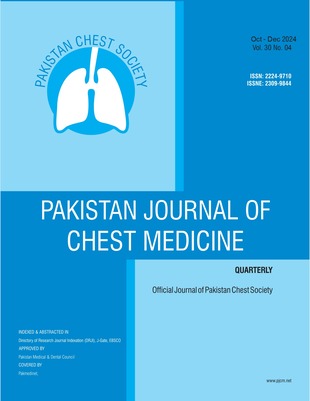Serum Total Bilirubin as a Potential Biomarker in Chronic Obstructive Pulmonary Disease: A Correlation Study
Keywords:
COPD, Serum Bilirubin, Antioxidant, InflammationAbstract
Background: The progressive inflammatory respiratory disorder known as chronic obstructive pulmonary disease (COPD) is a significant cause of morbidity and mortality globally. Though the association of bilirubin and COPD is still ambiguous, recent research suggests that bilirubin may protect against the onset of COPD. Objective: To determine the correlation between serum total bilirubin levels and chronic obstructive pulmonary disease. Methodology: This case-control study was conducted on 330 individuals from Lady Reading Hospital, Peshawar, aged ≥ 40 years, from 2019 to 2022. Their spirometry results divided participants into two groups: those with COPD (n = 165) and those without. Low (<0.6 mg/dL), intermediate (0.6-1.2 mg/dL), and high (>1.2 mg/dL) were the classifications given to the serum TB levels. Multivariate logistic regression was used to estimate COPD's adjusted odds ratios (ORs). Results: Those with COPD showed a significantly lower mean level of Total Serum Bilirubin in blood compared to controls (0.82 vs. 1.02mg/dL; p < 0.001). Low Total Bilirubin (TB) levels or concentrations by more than twofold odds for an individual having COPD (OR: 2.15; 95% CI: 1.24-3.73), while high TB levels conferred lower odds (OR: 0.52; 95% CI: 0.29-0.94) as compared to the intermediate group. Conclusion: A protective role of bilirubin, likely due to its anti-inflammatory and antioxidant properties, is provided by the association between lower levels of serum total bilirubin and an increased risk of COPD.References
Mahmud T. Chronic Obstructive Pulmonary Disease. A Common Disease with Vague Concept among Medicine Trainees. Pak J Chest Med. 2012;18(3):76-86.
Mei F, Dalmartello M, Bonifazi M, Bertuccio P, Levi F, Boffetta P, et al. Chronic obstructive pulmonary disease (COPD) mortality trends worldwide: An update to 2019. Respirology. 2022;27(11):941-50.
Adeloye D, Song P, Zhu Y, Campbell H, Sheikh A, Rudan I. Global, regional, and national prevalence of, and risk factors for, chronic obstructive pulmonary disease (COPD) in 2019: a systematic review and modelling analysis. Lancet Respir Med. 2022;10(5):447-58.
Albarrati AM, Gale NS, Munnery MM, Cockcroft JR, Shale DJ. Daily physical activity and related risk factors in COPD. BMC Pulm Med. 2020;20:1-8.
Samee M, Ullah I, Badar MM, Manzoor N, Nazeer MM. The relationship between constipation, nutritional status, and disease-related parameters in COPD patients: A comprehensive comparative analysis. Pak J Chest Med. 2022;28(3):308-15.
Kunutsor SK, Bakker SJ, Gansevoort RT, Chowdhury R, Dullaart RP. Circulating total bilirubin and risk of incident cardiovascular disease in the general population. Arterioscler Thromb Vasc Biol. 2015;35(3):716-24.
Suh S, Cho YR, Park MK, Kim DK, Cho NH, Lee MK. Relationship between serum bilirubin levels and cardiovascular disease. PLoS One. 2018;13(2):e0193041.
Kang SJ, Kim D, Park HE, Chung GE, Choi SH, Choi SY, et al. Elevated serum bilirubin levels are inversely associated with coronary artery atherosclerosis. Atherosclerosis. 2013;230(2):242-8.
MacDonald DM, Kunisaki KM, Wilt TJ, Baldomero AK. Serum bilirubin and chronic obstructive pulmonary disease (COPD): a systematic review. BMC Pulm Med. 2021;21:1-10.
Wei J, Zhao H, Fan G, Li J. Bilirubin treatment suppresses pulmonary inflammation in a rat model of smoke-induced emphysema. Biochem Biophys Res Commun. 2015;465(2):180-7.
Kim DE, Lee Y, Kim M, Lee S, Jon S, Lee SH. Bilirubin nanoparticles ameliorate allergic lung inflammation in a mouse model of asthma. Biomaterials. 2017;140:37-44.
Apperley S, Park HY, Holmes DT, Man SP, Tashkin D, Wise RA, et al. Serum bilirubin and disease progression in mild COPD. Chest. 2015;148(1):169-75.
Dai C, Wang Z, Yang H, Xiao S, Xu J, Deng Z, et al. Association between serum total bilirubin and COPD: results from a cross-sectional study and a bidirectional mendelian randomization analysis. Clin Epidemiol. 2022;14:289-98.
MacDonald DM, Kunisaki KM, Wilt TJ, Baldomero AK. Serum bilirubin and chronic obstructive pulmonary disease (COPD): a systematic review. BMC Pulm Med. 2021;21:1-10.
Leem AY, Kim YS, Lee JH, Kim TH, Kim HY, Oh YM, et al. Serum bilirubin level is associated with exercise capacity and quality of life in chronic obstructive pulmonary disease. Respir Res. 2019;20:1-8.
Brown KE, Sin DD, Voelker H, Connett JE, Niewoehner DE, Kunisaki KM. Serum bilirubin and the risk of chronic obstructive pulmonary disease exacerbations. Respir Res. 2017;18:1-7.
Horsfall LJ, Rait G, Walters K, Swallow DM, Pereira SP, Nazareth I, et al. Serum bilirubin and risk of respiratory disease and death. JAMA. 2011;305(7):691-7.
Wagner KH, Wallner M, Mölzer C, Gazzin S, Bulmer AC, Tiribelli C, et al. Looking to the horizon: the role of bilirubin in the development and prevention of age-related chronic diseases. Clin Sci. 2015;129(1):1-25.
Shapira U, Brezinski RY, Rogowski O, et al. Association between elevated serum bilirubin levels with preserved lung function under conditions of exposure to air pollution. BMC Pulm Med. 2021;21:119.
Baldomero AK, MacDonald DM, Kaplan A, Lock E, Cho MH, Bowler R, et al. Bilirubin-associated single nucleotide polymorphism (SNP) and respiratory health outcomes: a mendelian randomization study. Respir Res. 2023;24(1):190.
Downloads
Published
How to Cite
Issue
Section
License
Copyright (c) 2024 Pakistan Journal of Chest Medicine

This work is licensed under a Creative Commons Attribution-NonCommercial 4.0 International License.








